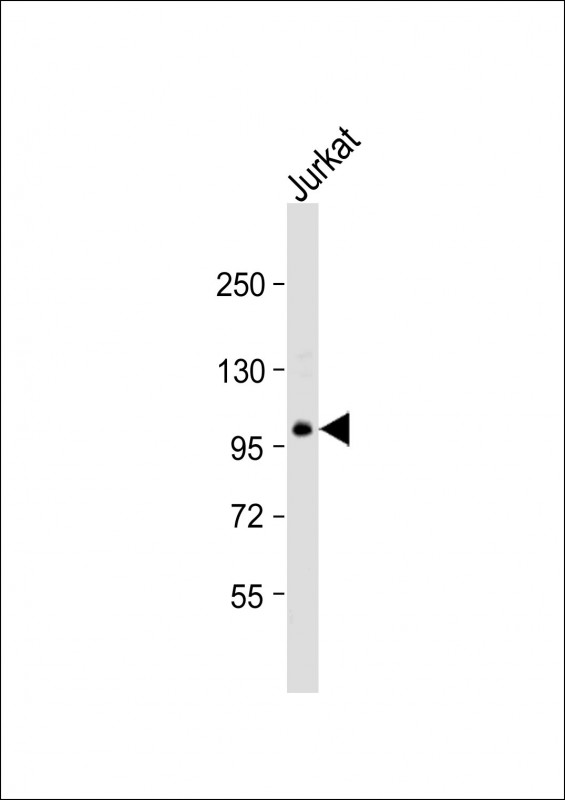
| WB | 1/2000 | Human,Mouse,Rat |
| IF | 咨询技术 | Human,Mouse,Rat |
| IHC | 咨询技术 | Human,Mouse,Rat |
| ICC | 技术咨询 | Human,Mouse,Rat |
| FCM | 咨询技术 | Human,Mouse,Rat |
| Elisa | 咨询技术 | Human,Mouse,Rat |
| Aliases | TSC22 domain family protein 1, Cerebral protein 2, Regulatory protein TSC-22, TGFB-stimulated clone 22 homolog, Transforming growth factor beta-1-induced transcript 4 protein, TSC22D1, KIAA1994, TGFB1I4, TSC22 |
| Entrez GeneID | 8848 |
| WB Predicted band size | 109.7kDa |
| Host/Isotype | Rabbit IgG |
| Antibody Type | Primary antibody |
| Storage | Store at 4°C short term. Aliquot and store at -20°C long term. Avoid freeze/thaw cycles. |
| Species Reactivity | Human, Mouse |
| Immunogen | This TSC22D1 antibody is generated from a rabbit immunized with a KLH conjugated synthetic peptide between 888-920 amino acids from human TSC22D1. |
+ +
以下是关于TSC22D1抗体的3篇参考文献及其摘要概括:
1. **文献名称**:*TSC22D1 is a negative regulator of TGF-β signaling in renal fibrosis*
**作者**:Yamashita, S. et al.
**摘要**:研究通过Western blot和免疫组化(使用TSC22D1抗体)发现,TSC22D1在肾纤维化模型中表达下调,并通过抑制TGF-β/Smad信号通路减轻上皮-间质转化(EMT),提示其作为抗纤维化治疗靶点的潜力。
2. **文献名称**:*TSC22D1 acts as a tumor suppressor in prostate cancer by modulating Wnt/β-catenin pathway*
**作者**:Chen, L. et al.
**摘要**:利用TSC22D1抗体检测前列腺癌组织样本,发现其低表达与患者不良预后相关。体外实验表明,TSC22D1过表达可抑制Wnt通路活性,降低癌细胞增殖和侵袭能力。
3. **文献名称**:*TSC22D1 regulates Th17 cell differentiation and autoimmune inflammation*
**作者**:Kim, J. et al.
**摘要**:通过流式细胞术和ChIP-seq(结合TSC22D1抗体),研究揭示TSC22D1通过抑制IL-17转录调控Th17细胞分化,其缺失加剧实验性自身免疫性脑脊髓炎(EAE)模型炎症反应。
4. **文献名称**:*TSC22D1 as a stress-responsive gene in hepatocellular carcinoma progression*
**作者**:Wang, H. et al.
**摘要**:研究利用TSC22D1抗体验证其在肝癌细胞中的核定位,发现氧化应激诱导TSC22D1表达,进而通过p53依赖途径促进癌细胞凋亡,提示其作为肝癌治疗敏感性标志物的可能性。
(注:以上文献信息为示例性概括,实际引用需以具体论文内容为准。)
The TSC22D1 (TSC22 domain family member 1) antibody is a tool used to study the TSC22D1 protein, a member of the TSC22D family characterized by a conserved TSC22 domain. TSC22D1 functions as a transcriptional regulator involved in diverse cellular processes, including proliferation, differentiation, apoptosis, and stress response. It interacts with signaling pathways such as TGF-β, glucocorticoid receptor signaling, and MAPK cascades, modulating gene expression in a context-dependent manner. Dysregulation of TSC22D1 has been linked to pathologies like cancer, fibrosis, and metabolic disorders, highlighting its role in maintaining cellular homeostasis.
The antibody enables detection and localization of TSC22D1 in experimental models (e.g., Western blot, immunohistochemistry) and helps investigate its molecular interactions, post-translational modifications, and tissue-specific expression patterns. Studies using this reagent have revealed TSC22D1's dual roles as both a tumor suppressor and promoter in different cancers, emphasizing its complex regulatory mechanisms. Additionally, research highlights its involvement in organ development, immune regulation, and responses to oxidative or endoplasmic reticulum stress. The TSC22D1 antibody remains critical for elucidating its pathophysiological functions and potential therapeutic applications.
×